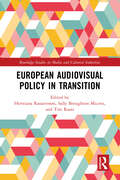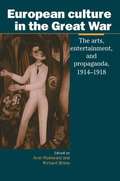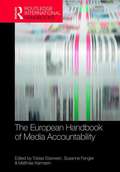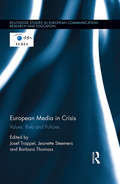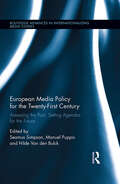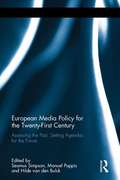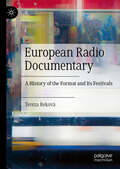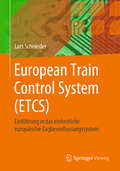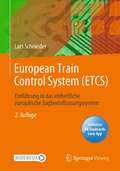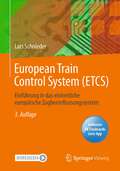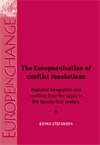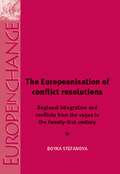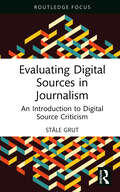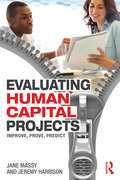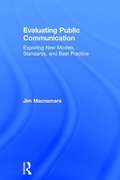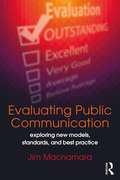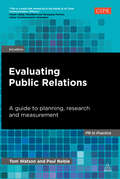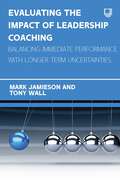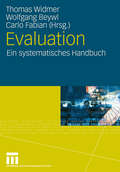- Table View
- List View
European Audiovisual Policy in Transition (Routledge Studies in Media and Cultural Industries)
by Heritiana Ranaivoson Sally Broughton Micova Tim RaatsThis book describes and critically addresses the innovations and shifts made in the revision of the Audiovisual Media Services Directive (AVMSD) adopted by the European Parliament and Council in 2018. Reflecting on European Union regulation and policy practice in all its Member States, the book’s unique approach places in-depth case study topics against the broader theoretical background. Taking a Europe-wide angle, an international team of authors focuses on key aspects of the AVMSD: the expansion of its scope to include video-sharing-platforms such as YouTube; the update of the rules for commercial communications; the first attempt for harmonized, minimal requirements at EU level regarding transparency of media ownership; new rules to ensure that video-on-demand services offer, invest in, and prioritise European content; the obligation on television distributors and smart TV manufacturers to pass on broadcasters’ signal without any interference, alteration or modification; and, the formalisation and consolidation of new forms of collaboration among national regulatory authorities. This thorough analysis of the cornerstone of European media policy makes this edited collection a crucial reference for scholars and students of media and cultural industries, media law and policy, European and EU media policy, and technology studies.
European Audiovisual Policy in Transition (Routledge Studies in Media and Cultural Industries)
This book describes and critically addresses the innovations and shifts made in the revision of the Audiovisual Media Services Directive (AVMSD) adopted by the European Parliament and Council in 2018. Reflecting on European Union regulation and policy practice in all its Member States, the book’s unique approach places in-depth case study topics against the broader theoretical background. Taking a Europe-wide angle, an international team of authors focuses on key aspects of the AVMSD: the expansion of its scope to include video-sharing-platforms such as YouTube; the update of the rules for commercial communications; the first attempt for harmonized, minimal requirements at EU level regarding transparency of media ownership; new rules to ensure that video-on-demand services offer, invest in, and prioritise European content; the obligation on television distributors and smart TV manufacturers to pass on broadcasters’ signal without any interference, alteration or modification; and, the formalisation and consolidation of new forms of collaboration among national regulatory authorities. This thorough analysis of the cornerstone of European media policy makes this edited collection a crucial reference for scholars and students of media and cultural industries, media law and policy, European and EU media policy, and technology studies.
European Culture In The Great War: The Arts, Entertainment And Propaganda, 1914-1918 (PDF)
by Aviel Roshwald Richard Stites Paul Kennedy Antoine Prost Emmanuel Sivan Jay WinterIt is commonplace to refer to the First World War as an historical watershed, but the nature of that great cataclysm's impact upon European society and culture remains a hotly debated topic. Many recent works have dealt with the Great War's role in shaping artistic and intellectual modernism and with the social history of the war. Yet the English-language literature remains dominated by a disproportionate emphasis on the western European experience. This book redresses the balance by giving equal attention to the countries of eastern and central Europe, and distinguishes itself by focusing specifically on cultural change during the course of the war, as distinct from the after-effects and memories of the conflict.
The European Handbook Of Media Accountability (PDF)
by Tobias Eberwein Susanne Fengler Matthias KarmasinIn recent years, the Leveson Inquiry in Great Britain, as well as the EU High Level Group on Media Freedom and Pluralism, have stirred heated debates about media accountability and media self-regulation across Europe. How responsible are journalists? How well-developed are infrastructures of media self-regulation in the different European countries? How much commitment to media accountability is there in the media industry and how actively do media users become involved in the process of media criticism via social media? With contributions from leading scholars in the field of journalism and mass communication, this handbook brings together reports on the status quo of media accountability in all EU members states, as well as key countries close to Europe, such as Turkey and Israel. Each chapter provides an up-to-date overview of media accountability structures as well as a synopsis of relevant research, exploring the role of media accountability instruments in each national setting, including both media self-regulation (such as codes of ethics, press councils, ombudspersons) and new instruments that involve audiences and stakeholder groups (such as media blogs and user comment systems). A theoretically informed, cross-national comparative analysis of the state of media accountability in contemporary Europe, this handbook constitutes an invaluable basis for further research and policy-making and will appeal to students and scholars of media studies and journalism, as well as policy-makers and practitioners.
European Media in Crisis: Values, Risks and Policies (Routledge Studies in European Communication Research and Education)
by Josef Trappel Jeanette Steemers Barbara ThomassWhen the financial markets collapsed in 2008, the media industry was affected by a major slump in advertising revenues, and a formerly highly successful business model fell into a state of decay. This economic crisis has threatened core social values of contemporary democracies, such as freedom, diversity and equality. Taking a normative and policy perspective, this book discusses threats and opportunities for the media industry in Europe: What are the implications of the crisis for professional journalism, the media industry, and the process of political communication? Can non- state and non-market actors profit from the crisis? And what are media policy answers at the national and European level?
European Media in Crisis: Values, Risks and Policies (Routledge Studies in European Communication Research and Education)
by Josef Trappel Jeanette Steemers Barbara ThomassWhen the financial markets collapsed in 2008, the media industry was affected by a major slump in advertising revenues, and a formerly highly successful business model fell into a state of decay. This economic crisis has threatened core social values of contemporary democracies, such as freedom, diversity and equality. Taking a normative and policy perspective, this book discusses threats and opportunities for the media industry in Europe: What are the implications of the crisis for professional journalism, the media industry, and the process of political communication? Can non- state and non-market actors profit from the crisis? And what are media policy answers at the national and European level?
European Media Policy for the Twenty-First Century: Assessing the Past, Setting Agendas for the Future (Routledge Advances in Internationalizing Media Studies)
by Seamus Simpson Manuel Puppis Hilde Van Den BulckMedia policy issues sit at the heart of the structure and functioning of media systems in Europe and beyond. This book brings together the work of a range of leading media policy scholars to provide inroads to a better understanding of how effective media policies can be developed to ensure a healthy communication sector that contributes to the wellbeing of individual citizens, as well as a more democratic society. Faced with a general atmosphere of disillusionment in the European project, one of the core questions tackled by the volume’s contributors is: what scope is there for European media policy that can exist beyond the national level? Uniquely, the volume’s chapters are structured around four key policy themes: media convergence; the continued role and position of public regulatory intervention in media policy; policy issues arising from the development of new electronic communication network environments; and lessons for European media policy from cases beyond the EU. In its chapters, the volume provides enriched understandings of the role and significance of policy actors, institutions, structures, instruments and processes in communication and media policy.
European Media Policy for the Twenty-First Century: Assessing the Past, Setting Agendas for the Future (Routledge Advances in Internationalizing Media Studies)
by Seamus Simpson Manuel Puppis Hilde Van den BulckMedia policy issues sit at the heart of the structure and functioning of media systems in Europe and beyond. This book brings together the work of a range of leading media policy scholars to provide inroads to a better understanding of how effective media policies can be developed to ensure a healthy communication sector that contributes to the wellbeing of individual citizens, as well as a more democratic society. Faced with a general atmosphere of disillusionment in the European project, one of the core questions tackled by the volume’s contributors is: what scope is there for European media policy that can exist beyond the national level? Uniquely, the volume’s chapters are structured around four key policy themes: media convergence; the continued role and position of public regulatory intervention in media policy; policy issues arising from the development of new electronic communication network environments; and lessons for European media policy from cases beyond the EU. In its chapters, the volume provides enriched understandings of the role and significance of policy actors, institutions, structures, instruments and processes in communication and media policy.
European Media Policy For The Twenty-first Century: Assessing The Past, Setting Agendas For The Future (PDF)
by Seamus Simpson Manuel Puppis Hilde Van Den BulckMedia policy issues sit at the heart of the structure and functioning of media systems in Europe and beyond. This book brings together the work of a range of leading media policy scholars to provide inroads to a better understanding of how effective media policies can be developed to ensure a healthy communication sector that contributes to the wellbeing of individual citizens, as well as a more democratic society. Faced with a general atmosphere of disillusionment in the European project, one of the core questions tackled by the volume#65533;s contributors is: what scope is there for European media policy that can exist beyond the national level? Uniquely, the volume#65533;s chapters are structured around four key policy themes: media convergence; the continued role and position of public regulatory intervention in media policy; policy issues arising from the development of new electronic communication network environments; and lessons for European media policy from cases beyond the EU. In its chapters, the volume provides enriched understandings of the role and significance of policy actors, institutions, structures, instruments and processes in communication and media policy.
European Media Policy For The Twenty-first Century: Assessing The Past, Setting Agendas For The Future
by Seamus Simpson Manuel Puppis Hilde Van Den BulckMedia policy issues sit at the heart of the structure and functioning of media systems in Europe and beyond. This book brings together the work of a range of leading media policy scholars to provide inroads to a better understanding of how effective media policies can be developed to ensure a healthy communication sector that contributes to the wellbeing of individual citizens, as well as a more democratic society. Faced with a general atmosphere of disillusionment in the European project, one of the core questions tackled by the volume#65533;s contributors is: what scope is there for European media policy that can exist beyond the national level? Uniquely, the volume#65533;s chapters are structured around four key policy themes: media convergence; the continued role and position of public regulatory intervention in media policy; policy issues arising from the development of new electronic communication network environments; and lessons for European media policy from cases beyond the EU. In its chapters, the volume provides enriched understandings of the role and significance of policy actors, institutions, structures, instruments and processes in communication and media policy.
European Radio Documentary: A History of the Format and Its Festivals
by Tereza RekováThis book studies the history and significance of radio documentaries in Europe, and the institutions that are specialized on this genre. Focused on the 50-year history of the International Feature Conference (an annual gathering of radio documentarians from around the world), the book discusses the Prix Europa, Prix Italia, the Third Coast International Audio Festival, and the HearSay Audio Arts Festival. The book tells the story of people who chose sound as their lifestyle and who spread their passion worldwide.
European Train Control System: Einführung in das einheitliche europäische Zugbeeinflussungssystem (Essentials Ser.)
by Lars SchniederDieses Buch ist eine strukturierte Einführung in das europaweit einheitliche Zugbeeinflussungssystem ETCS (European Train Control System). Der Autor führt in die Motivation und Rechtsgrundlagen des ETCS ein. Der Aufbau der unterschiedlichen Ausrüstungsstufen wird dargestellt und die einzelnen Komponenten der Fahrzeug- und Streckeneinrichtung beschrieben. Die umfassende Darstellung der technischen Grundprinzipien des ETCS umfasst sowohl die Sicherungsfunktionen als auch ihre Umsetzung in den unterschiedlichen Betriebsarten. Die Kenntnis dieser technischen Zusammenhänge schafft ein Verständnis, wie ETCS zukünftig einen Beitrag für einen sicheren, wirtschaftlichen und leistungsfähigen Bahnbetrieb leisten kann.
European Train Control System (ETCS): Einführung in das einheitliche europäische Zugbeeinflussungssystem
by Lars SchniederDieses Buch ist eine strukturierte Einführung in das europaweit einheitliche Zugbeeinflussungssystem ETCS (European Train Control System). Der Autor führt in die Motivation und Rechtsgrundlagen des ETCS ein. Der Aufbau der unterschiedlichen Ausrüstungsstufen wird dargestellt und die einzelnen Komponenten der Fahrzeug- und Streckeneinrichtung beschrieben. Die umfassende Darstellung der technischen Grundprinzipien des ETCS umfasst sowohl die Sicherungsfunktionen als auch ihre Umsetzung in den unterschiedlichen Betriebsarten. Die Kenntnis dieser technischen Zusammenhänge schafft ein Verständnis, wie ETCS zukünftig einen Beitrag zu einem sicheren, wirtschaftlichen und leistungsfähigen Bahnbetrieb leisten kann.Zusätzliche Fragen per App: Laden Sie die Springer Nature Flashcards-App kostenlos herunter und nutzen Sie exklusives Zusatzmaterial, um Ihr Wissen zu prüfen.
European Train Control System: Einführung in das einheitliche europäische Zugbeeinflussungssystem (Essentials Ser.)
by Lars SchniederDieses Buch ist eine strukturierte Einführung in das europaweit einheitliche Zugbeeinflussungssystem ETCS (European Train Control System). Der Autor führt in die Motivation und Rechtsgrundlagen des ETCS ein. Der Aufbau der unterschiedlichen Ausrüstungsstufen wird dargestellt und die einzelnen Komponenten der Fahrzeug- und Streckeneinrichtung beschrieben. Die umfassende Darstellung der technischen Grundprinzipien des ETCS umfasst sowohl die Sicherungsfunktionen als auch ihre Umsetzung in den unterschiedlichen Betriebsarten. Die Kenntnis dieser technischen Zusammenhänge schafft ein Verständnis, wie ETCS zukünftig einen Beitrag zu einem sicheren, wirtschaftlichen und leistungsfähigen Bahnbetrieb leisten kann.Zusätzliche Fragen per App: Laden Sie die Springer Nature Flashcards-App kostenlos herunter und nutzen Sie exklusives Zusatzmaterial, um Ihr Wissen zu prüfen.
The Europeanisation of Conflict Resolutions: Regional integration and conflicts from the 1950s to the 21st century (PDF) (Europe in Change)
by Boyka StefanovaThis book is about the EU’s role in conflict resolution and reconciliation in Europe. Ever since it was implemented as a political project of the post-World War II reality in Western Europe, European integration has been credited with performing conflict resolution functions. It allegedly transformed the long-standing adversarial relationship between France and Germany into a strategic partnership. Conflict in Western Europe became obsolete. The end of the Cold War further reinforced its role as a regional peace project. While these evolutionary dynamics are uncontested, the deeper meaning of the process, its transformative power, is still to be elucidated. How does European integration restore peace when its equilibrium is broken and conflict or the legacies of enmity persist? This book sets out to do exactly that. It explores the peace and conflict-resolution role of European integration by testing its somewhat vague, albeit well-established, macro-political rationale of a peace project in the practical settings of conflicts. The analytical lens of that of Europeanization. The central argument of the book is that the evolution of the policy mix, resources, framing influences and political opportunities through which European integration affects conflicts and processes of conflict resolution demonstrates a historical trend through which the EU has become an indispensable factor of conflict resolution . It begins with the pooling together of policy-making at the European level for the management of particular sectors (early integration in the European Coal and Steel Community) through the functioning of core EU policies (Northern Ireland) to the challenges of enlargement (Cyprus) and the European perspective for the Western Balkans (Kosovo). The book will be of value to academics and non-expert observers alike with an interest in European integration and peace studies.
The Europeanisation of Conflict Resolutions: Regional integration and conflicts from the 1950s to the 21st century (Europe in Change)
by Boyka StefanovaThis book is about the EU’s role in conflict resolution and reconciliation in Europe. Ever since it was implemented as a political project of the post-World War II reality in Western Europe, European integration has been credited with performing conflict resolution functions. It allegedly transformed the long-standing adversarial relationship between France and Germany into a strategic partnership. Conflict in Western Europe became obsolete. The end of the Cold War further reinforced its role as a regional peace project. While these evolutionary dynamics are uncontested, the deeper meaning of the process, its transformative power, is still to be elucidated. How does European integration restore peace when its equilibrium is broken and conflict or the legacies of enmity persist? This book sets out to do exactly that. It explores the peace and conflict-resolution role of European integration by testing its somewhat vague, albeit well-established, macro-political rationale of a peace project in the practical settings of conflicts. The analytical lens of that of Europeanization. The central argument of the book is that the evolution of the policy mix, resources, framing influences and political opportunities through which European integration affects conflicts and processes of conflict resolution demonstrates a historical trend through which the EU has become an indispensable factor of conflict resolution . It begins with the pooling together of policy-making at the European level for the management of particular sectors (early integration in the European Coal and Steel Community) through the functioning of core EU policies (Northern Ireland) to the challenges of enlargement (Cyprus) and the European perspective for the Western Balkans (Kosovo). The book will be of value to academics and non-expert observers alike with an interest in European integration and peace studies.
Evaluating Digital Sources in Journalism: An Introduction to Digital Source Criticism (Routledge Focus on Journalism Studies)
by Ståle GrutBuilding on a rich journalistic tradition of critical source analysis, this book considers the impact of the move from analogue to digital sources on information quality and presents methods and tools to verify information found online and help counter the spread of misinformation. Evaluating Digital Sources in Journalism critically maps the prevalence of online manipulation, particularly images and videos from social media platforms, and considers the tools needed both to carry out and to counter this. Strategies are proposed to help readers evaluate content, context and sources, and ultimately build a foundation for carrying out their own online open-source investigations. The author brings together theories and best practices from a broad range of literature, including modern Scandinavian research on the concept of “source criticism”, journalism and technology studies, advanced forensic verification research, and literature designed for practitioners, including blogs and industry publications. Evaluating Digital Sources in Journalism is recommended reading for advanced journalism students and journalism practitioners.
Evaluating Digital Sources in Journalism: An Introduction to Digital Source Criticism (Routledge Focus on Journalism Studies)
by Ståle GrutBuilding on a rich journalistic tradition of critical source analysis, this book considers the impact of the move from analogue to digital sources on information quality and presents methods and tools to verify information found online and help counter the spread of misinformation. Evaluating Digital Sources in Journalism critically maps the prevalence of online manipulation, particularly images and videos from social media platforms, and considers the tools needed both to carry out and to counter this. Strategies are proposed to help readers evaluate content, context and sources, and ultimately build a foundation for carrying out their own online open-source investigations. The author brings together theories and best practices from a broad range of literature, including modern Scandinavian research on the concept of “source criticism”, journalism and technology studies, advanced forensic verification research, and literature designed for practitioners, including blogs and industry publications. Evaluating Digital Sources in Journalism is recommended reading for advanced journalism students and journalism practitioners.
Evaluating Human Capital Projects: Improve, Prove, Predict
by Jane Massy Jeremy HarrisonHow can we be sure that all those projects, programmes and activities that depend for their quality, efficiency and effectiveness on people’s performance have met their objectives? How can we improve the ways in which these projects, programmes and activities are planned so that realistic and useful measurement of their outcomes and value for money becomes possible? How can we produce from these evaluations data of the quality and a standard required to drive future improvement? Evaluating Human Capital Projects addresses these issues for professionals in the private, the public and the not-for-profit sectors. It shows them how to plan and track their investments with the professionalism and discipline widely applied to other capital investments. It is also written as a sourcebook for both professional and Masters-level students in business, health and a wide range of socio-economic disciplines. It addresses effective planning, stakeholder engagement, result-tracking, the identification and removal of barriers to good performance. It provides ideas, theoretical background, extensive references to practice and analysis from the authors’ extensive experience or planning, collection of data, analysis of data and attribution, and reporting to drive future improvement. It is intended to raise the bar on the professionalism with which human capital investments are planned and measured.
Evaluating Human Capital Projects: Improve, Prove, Predict
by Jane Massy Jeremy HarrisonHow can we be sure that all those projects, programmes and activities that depend for their quality, efficiency and effectiveness on people’s performance have met their objectives? How can we improve the ways in which these projects, programmes and activities are planned so that realistic and useful measurement of their outcomes and value for money becomes possible? How can we produce from these evaluations data of the quality and a standard required to drive future improvement? Evaluating Human Capital Projects addresses these issues for professionals in the private, the public and the not-for-profit sectors. It shows them how to plan and track their investments with the professionalism and discipline widely applied to other capital investments. It is also written as a sourcebook for both professional and Masters-level students in business, health and a wide range of socio-economic disciplines. It addresses effective planning, stakeholder engagement, result-tracking, the identification and removal of barriers to good performance. It provides ideas, theoretical background, extensive references to practice and analysis from the authors’ extensive experience or planning, collection of data, analysis of data and attribution, and reporting to drive future improvement. It is intended to raise the bar on the professionalism with which human capital investments are planned and measured.
Evaluating Public Communication: Exploring New Models, Standards, And Best Practice (PDF)
by Jim MacnamaraEvaluating Public Communication addresses the widely reported lack of rigorous outcome and impact-oriented evaluation in advertising; public relations; corporate, government, political and organizational communication and specialist fields, such as health communication. This transdisciplinary analysis integrates research literature from each of these fields of practice, as well as interviews, content analysis and ethnography, to identify the latest models and approaches. Chapters feature: #65533; a review of 30 frameworks and models that inform processes for evaluation in communication, including the latest recommendations of industry bodies, evaluation councils and research institutes in several countries; #65533; recommendations for standards based on contemporary social science research and industry initiatives, such as the IPR Task Force on Standards and the Coalition for Public Relations Research Standards; #65533; an assessment of metrics that can inform evaluation, including digital and social media metrics, 10 informal research methods and over 30 formal research methods for evaluating public communication; #65533; evaluation of public communication campaigns and projects in 12 contemporary case studies. Evaluating Public Communication provides clear guidance on theory and practice for students, researchers and professionals in PR, advertising and all fields of communication.
Evaluating Public Communication: Exploring New Models, Standards, And Best Practice (PDF)
by Jim MacnamaraEvaluating Public Communication addresses the widely reported lack of rigorous outcome and impact-oriented evaluation in advertising; public relations; corporate, government, political and organizational communication and specialist fields, such as health communication. This transdisciplinary analysis integrates research literature from each of these fields of practice, as well as interviews, content analysis and ethnography, to identify the latest models and approaches. Chapters feature; a review of 30 frameworks and models that inform processes for evaluation in communication, including the latest recommendations of industry bodies, evaluation councils and research institutes in several countries; recommendations for standards based on contemporary social science research and industry initiatives, such as the IPR Task Force on Standards and the Coalition for Public Relations Research Standards; an assessment of metrics that can inform evaluation, including digital and social media metrics, 10 informal research methods and over 30 formal research methods for evaluating public communication; evaluation of public communication campaigns and projects in 12 contemporary case studies. Evaluating Public Communication provides clear guidance on theory and practice for students, researchers and professionals in PR, advertising and all fields of communication.
Evaluating Public Relations: A Guide to Planning, Research and Measurement (PR In Practice)
by Tom Watson Paul NobleOperating under tight budget constraints and with an ever-increasing range of tools and technologies to choose from, PR professionals have never been under so much pressure to justify their decisions. Evaluating Public Relations advises PR practitioners at all levels on how to demonstrate clearly and objectively the impact that their work has to their clients and managers. The authors draw on both their practical and academic experience to discuss a diverse range of evaluation methods and strategies.This fully updated edition of Evaluating Public Relations includes coverage and advice on the industry standards on PR measurement. Covering both theory and practice and containing case studies on Philips, Pepsi, St John Ambulance, Medicare and Westminster City Council, it is an essential handbook for both students and experienced practitioners.
Evaluating the Impact of Leadership Coaching: Balancing Immediate Performance with Longer Term Uncertainties
by Mark Jamieson Tony WallThis book offers an essential evaluation model so that leadership coaches and stakeholders can demonstrate the impact of their coaching programmes, challenging current thinking that the return on investment from leadership coaching is too complex to measure. The book is both practical and strategically informative, supporting coaches and organisations to plan confidently for the future as they collaborate over both short- and long-term decisions.The book provides:•Ideas and insights into the dissemination of evaluation data to key strategic destinations•Case studies that show how to evaluate Return on Investment (RoI) for both financial and non-financial targets such as behaviours, potential and wellbeing•Tips, templates and reflective activitiesRe-imaging evaluation as a strategic opportunity rather than an operational task enables leaders to perform in an agile way that is responsive to local and global uncertainties and business priorities.“It’s a pleasure to find a comprehensive, insightful and evidence-backed approach with practical examples of how [evaluation in coaching] can be done.”David Clutterbuck, Special Ambassador, European Mentoring and Coaching Council“A real aid for leaders, managers and indeed all organizational members.”Professor Peter Stokes, Leicester Castle Business School, De Montfort University, UK“‘Evaluating the Impact of Leadership Coaching’ makes for a great read from two writers interested in helping move the debate from the facile to the factual, and from ego to evidence.”Prof Jonathan Passmore, Senior VP CoachHub and Professor of Coaching and Behavioural Change, Henley Business School, UKMark Jamieson is an award-winning leadership coach and founder of the GreenWing Project focused on the development of young leaders. His coaching specialisms include youth leadership and women in business leadership.Tony Wall is Professor at Liverpool Business School, Liverpool John Moores University, UK, and an affiliated professor at Stockholm University, Sweden. Working with the European Mentoring & Coaching Council (EMCC) in Brussels, he founded the EMCC provocations series.
Evaluation: Ein systematisches Handbuch
by Thomas Widmer Wolfgang Beywl Carlo FabianEvaluation als Instrument zur systematischen und transparenten Bewertung von Projekten, Massnahmen, Programmen, Gesetzen und anderen Gegenständen hat in den letzten zwei Dekaden in Kontinentaleuropa stark an Bedeutung gewonnen. Evaluationstätigkeiten werden auf der Angebots- und Nachfrageseite professionalisiert. Die Gründung entsprechender Fachgesellschaften, die Schaffung spezifischer Aus- und Weiterbildungsangebote und die Etablierung fachlicher Standards belegen dies. Dieser Sammelband spiegelt Entwicklungsstand und Leistungsprofil der Evaluation in Deutschland, Österreich und der Schweiz wider. Namhafte, mit der jeweiligen Landessituation vertraute Autorinnen und Autoren leisten Beiträge zu zehn Themenfeldern: Agrarpolitik, Arbeitsmarktpolitik, Bildung, Energie- und Umweltpolitik, Entwicklungszusammenarbeit, Forschung und Technologie, Gesundheit, institutionelle Politik, Raumentwicklungspolitik und Soziale Arbeit. Ländervergleichende Beiträge arbeiten Gemeinsamkeiten und Unterschiede themenspezifisch heraus. Ergänzt werden diese vierzig Beiträge um Querschnittsbeiträge zur Institutionalisierung und zur Nutzung von Evaluation in den drei Ländern. "Expansion, Vielfalt und Divergenz der Evaluation" lautet die Quintessenz des übergreifenden Themenvergleichs im abschliessenden Beitrag.
